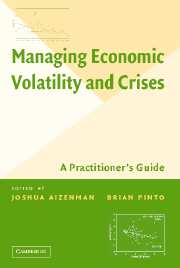Technical Appendix
Published online by Cambridge University Press: 25 July 2009
Summary
This appendix provides a basic set of derivations and the intuition underlying the technical concepts in selected chapters. The audience we have in mind is the busy, and possibly impatient, practitioner who will want guidance on how to interpret the various analytical approaches without necessarily acquiring a textbook level of knowledge. The more sophisticated reader is likely to want more. In anticipation of this need, we have a list of references to supplement the material presented here.
The appendix is divided into three main parts. Each part is in turn divided into a few sections, which are serially numbered throughout the appendix. Part I is devoted to the basics of volatility, including definitions and measurement, as well as trend-cycle decomposition methods. Part II discusses commodity price volatility and the basics of hedging techniques. Part III contains an overview of macroeconomic vulnerability assessment and the basic concepts of public debt sustainability, while also deriving related equations.
PART I. BASICS OF VOLATILITY
Definition and Measurement of Volatility
A. DEFINITION OF VOLATILITY. Intuitively, volatility can be thought of as the step-size of a random variable: the amount by which it is likely to change, or its step-size up or down, during a given time interval, usually, a year. More volatile variables have larger step-sizes, that is, are liable to vary more up or down. For convenience of presentation, two types of volatility can be distinguished: “Crisis or Boom” and “Trend or Structural” volatility.
- Type
- Chapter
- Information
- Managing Economic Volatility and CrisesA Practitioner's Guide, pp. 521 - 566Publisher: Cambridge University PressPrint publication year: 2005
References
- 1
- Cited by



